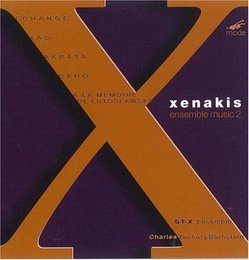| All Artists: Mathew Cashman, Iannis Xenakis, Charles Zachary Bornsteinm, Six Ensemble Xanakis USA, Susan Cook, Shawn Tracy Title: Xenakis: Échange/Okho/Xas/Akrata/A La M±moire De Witold Lutoslawski Members Wishing: 3 Total Copies: 0 Label: Mode Release Date: 11/19/1996 Genre: Classical Styles: Chamber Music, Forms & Genres, Concertos, Instruments, Reeds & Winds Number of Discs: 1 SwapaCD Credits: 1 UPC: 764593005629 |
Search - Mathew Cashman, Iannis Xenakis, Charles Zachary Bornsteinm :: Xenakis: Échange/Okho/Xas/Akrata/A La M±moire De Witold Lutoslawski
 | Mathew Cashman, Iannis Xenakis, Charles Zachary Bornsteinm Xenakis: Échange/Okho/Xas/Akrata/A La M±moire De Witold Lutoslawski Genre: Classical
|
Larger Image |
CD Details |
CD ReviewsTimbral interesting music on grids scarecrow | Chicago, Illinois United States | 02/07/2005 (5 out of 5 stars) "Cannot ad to much more the Edward's review, the Echange really makes you feel the profound power of the Bass Clarinet, like the Violoncello, it is an instrument of enormous potentialities, and expressive dimension, simply the way the timbre weaves between "noise-like" tones to more "normal", all relative, for what is normal or stable is always open to question in Xenakis, and must be placed within the context of his music philosophy. Incredible playing, Likewise the Sax Quartet XAS is a real tour de force, utilizing nasty quarter-tones, and really uncomfortable positions for all the players scaling the upper registers of their range. If you look for listening guides in Xenakis just simply the "freedom" his work reveal, unpredictable, with sharp contrasts, like it is an incomplete work. The saxes have a kind of industrial, steel-mill like ambience to their timbre and the way Xenakis utilizes them. I've heard live performances of this work, and it can radically change, Here the players you feel are deeply aware of the extended language of Xenakis, the alost "electroni"like sound the saxes emit. I like the Memoire to Lutoslawski, and incrredible what you can do with two trumpets nad two horns. It still has that Xenakis feel for "overwhelming" you, but here it is a bit less, more concerned with the expressiveness of the linear motions, it has a sense of disquiet about it, but not end-of-the-world. Akrata has a sterile,untarnished beauty from the Sixties-like the fashionable art work of the times of Vasarely- the repetition of single tones, over three four beats,building little atom cell-like densities all dovetailing overlapping,superimposing themselves within the 16 piece ensemble. Percussion and Xenakis don't seem to make magic together, I cannot name a single interesting work, the "Psappha" for a large array of percussion is relatively predictable and timid, and it does burst out into the noise-world as his other works for "un-noise" instruments as piano winds and strings. Yes this Okho is a minor work more etude-like." Excellent Chamber Music from a Great Composer E. Murphy-Mancini | Wilbraham, MA USA | 03/13/2006 (5 out of 5 stars) "Xenakis was one of the great, late 20th century composers. His music, though rough and very forward in its substance, is nonetheless completely original. These chamber works are a case in point. They use widely varying and original ensembles and huge amounts of the musical language.
Echange utilizes an unusual solo instrument: the bass clarinet. However, this bass member of the woodwinds can create many interesting colors and timbres not usually associated with the bass range of instruments. The bass clarinet is called to use many special effects, including flutter tonguing and multiphonics. The piece uses the block chord writing that Xenakis uses in many of his works. Okho seems to get the idea of traditional African djembe playing exactly right. I don't know how Xenakis managed that. He not only creates the polyrhythms found in African djembe music, but he also shows how that music needs incredible patience to listen to. Many pieces of djembe music can last for nearly an hour, and a previous reviewer showed how our culture does not have that kind of attention span. Xas is my personal favorite on the CD. It is a saxophone quartet (and so aptly named), but the players have to be much more than your run-of-the-mill jazz club rats. The parts rise extremely high into the stratosphere, just to crash back down seconds later. Like all of Xenakis' music, it takes some listening to get used to the harmonies, but this piece ages very well. It is a schizophrenic rollercoaster ride that lets up only in brief intervals. Akrata is the largest work on the disc, calling for 16 players: eight winds and eight brasses. Xenakis keeps the two groups separate, with the brass playing repeated staccato rhythms and the winds playing passages that are more legato. It is a much earlier work than all of the other works on the disc, coming from 1965. During the previous two decades, Xenakis had been working as an architect under Le Corbusier. He was composing in a mathematical vein, using equations as an inspiration for his work. One can hear these ideas very clearly in this work. The final piece is a tribute to Witold Lutos?awski. Scored for two trumpets and two horns, it hearkens back to Xenakis' earlier styles. It is very austere and severe, but it is brief. It is not quite as strong a work as some of the other selections, but is coherent and has some interesting parts. The ST-X Ensemble under Charles Zachary Bornstein is just amazing. They work with Xenakis' extremely challenging scores and succeed brilliantly in performance. They were supervised by the composer himself, so these are guaranteed performances. These are great pieces and performances, and are well worth the price." |

 Track Listings (5) - Disc #1
Track Listings (5) - Disc #1